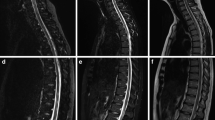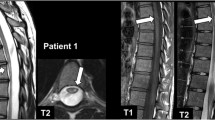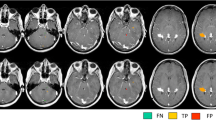Abstract.
The current optimal imaging protocol in spinal cord MR imaging in patients with multiple sclerosis includes a long TR conventional spin-echo (CSE) sequence, requiring long acquisition times. Using short tau inversion recovery fast spin-echo (fast STIR) sequences both acquisition time can be shortened and sensitivity in the detection of multiple sclerosis (MS) abnormalities can be increased. This study compares both sequences for the potential to detect both focal and diffuse spinal abnormalities. Spinal cords of 5 volunteers and 20 MS patients were studied at 1.0 T. Magnetic resonance imaging included cardiac-gated sagittal dual-echo CSE and a cardiac-gated fast STIR sequence. Images were scored regarding number, size, and location of focal lesions, diffuse abnormalities and presence/hindrance of artifacts by two experienced radiologists. Examinations were scored as being definitely normal, indeterminate, or definitely abnormal. Interobserver agreement regarding focal lesions was higher for CSE (ϰ = 0.67) than for fast STIR (ϰ = 0.57) but did not differ significantly. Of all focal lesions scored in consensus, 47 % were scored on both sequences, 31 % were only detected by fast STIR, and 22 % only by dual-echo CSE (n. s.). Interobserver agreement for diffuse abnormalities was lower with fast STIR (ϰ = 0.48) than dual-echo CSE (ϰ = 0.65; n. s.). After consensus, fast STIR showed in 10 patients diffuse abnormalities and dual-echo CSE in 3. After consensus, in 19 of 20 patients dual-echo CSE scans were considered as definitely abnormal compared with 17 for fast STIR. The fast STIR sequence is a useful adjunct to dual-echo CSE in detecting focal abnormalities and is helpful in detecting diffuse MS abnormalities in the spinal cord. Due to the frequent occurrence of artifacts and the lower observer concordance, fast STIR cannot be used alone.
Similar content being viewed by others
Author information
Authors and Affiliations
Additional information
Received: 9 September 1999; Revised: 14 December 1999; Accepted: 16 December 1999
Rights and permissions
About this article
Cite this article
Bot, J., Barkhof, F., Lycklama à Nijeholt, G. et al. Comparison of a conventional cardiac-triggered dual spin-echo and a fast STIR sequence in detection of spinal cord lesions in multiple sclerosis. Eur Radiol 10, 753–758 (2000). https://doi.org/10.1007/s003300050998
Issue Date:
DOI: https://doi.org/10.1007/s003300050998




